To identify old rocking horses is not always easy, particularly early horses on bow rockers, often made by skilled but unknown craftsmen. A number of specialist rocking horse makers emerged in the 19th century who started by making horses on bows, then from 1880, on safety stands to the Marqua patent, continuing long after the patent expired. Many continued making horses well into the 20th century.
The most prolific and well known of these were:
F. H. Ayres of London, G. & J. Lines of London and J. Collinson of Liverpool.
Examples of their rocking horses are shown below, along with those of some less well known makers, whose horses are more difficult to identify. The following may help in identifying old rocking horses, but is not intended to be a comprehensive guide – just pointers in the right direction. If you would like further help, please email a photo, taken like these from the side, showing the whole horse and stand, when we may be able to help to identify old rocking horses made by known English makers. Sadly it may not always be possible to Identify old rocking horses made by amateur or very obscure makers.
F. H. AYRES of London – regarded as one of the foremost English rocking horse makers.
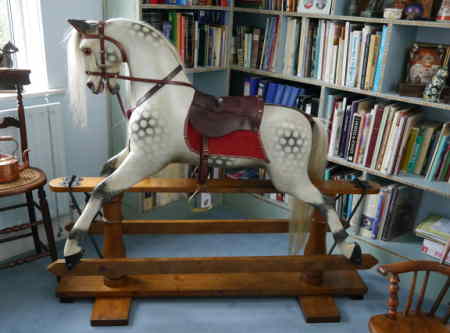
A fully restored horse on safety stand typical of this maker, with the nicely shaped body, well carved head with fairly straight nose. Ends of the hoof rails are pointed and bevelled. Stand columns are a substantial baluster shape with a raised bead towards the top, and four fixing bolts to the swing iron brackets. Earlier extra carved models had indented hoof rails rather than plain, and in later models the stand columns were much simpler with no raised bead. Small horses had simpler brackets with just three fixing bolts.
G. & J. LINES of London – Another maker of superb English rocking horses, which are equal in quality to Ayres.

A fully restored, very elegant and beautiful extra carved No 21 horse, with well shaped body, finely carved head with slightly ‘dished’ face, rounded paddle-shaped ends to the hoof rails, fairly simple though substantial shape to the stand columns, and brackets which were fixed with two screws and one bolt. The addition of ‘bowler hats’ in brass to cover the swing iron ends is typical of this maker. Later ‘Sportiboy’ horses by Lines had simpler carving to the horses, and the addition of a sunken bead half way up the stand column, ‘bowler hats’ on top of the stand covered the column spigots.
J. COLLINSON & SONS of Liverpool – A very prolific and successful rocking horse maker, in business until the 1990’s
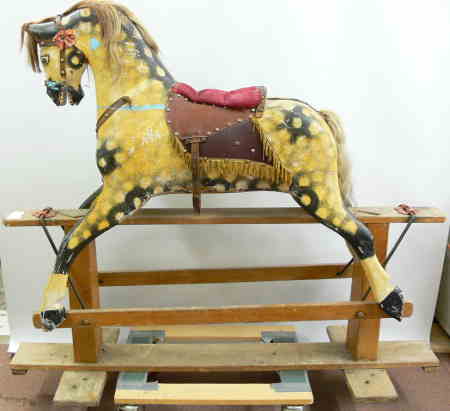
To identify old rocking horses by this maker is possibly the easiest of all, since they were made in vast numbers over a long period and the shapeof the horse and paintwork are very distinctive. This is a fairly typical Collinson rocking horse in its original paint and tack. Eyes are metal studs with painted detail.
Carving of the head and body is simple, paintwork is not subtle. Construction relies heavily on nails, which attach the legs, (instead of the more complex mortise and tenon joints of the Ayres and Lines horses.) The stand consists of fairly thin sections, resting on square tapered columns, held together with large nails, which are concealed by plywood or hardboard diamond shaped lozenges. Saddle tops are usually red corduroy, with leathercloth flaps and saddlecloth. Brackets are usually similar to Lines, being fixed with two screws and a bolt, though other brackets do turn up occasionally.
It is not quite so easy to identify old rocking horses by the following, but these photographs may help. These rocking horses are by makers who are less well known than the big three, but some of whom nevertheless produced wonderful horses, as well carved and as beautiful as the Ayres and Lines horses.
SWAN TOYS of Leeds – Beautifully carved rocking horses, often made for Gamages Department Store – quite rare.
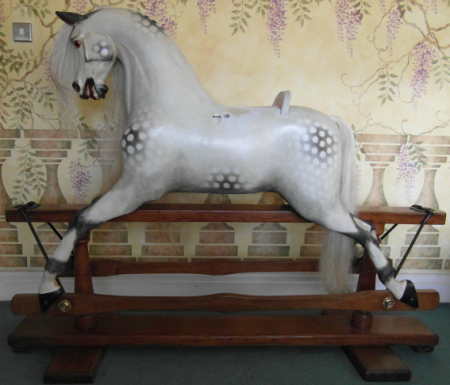
A restored but not yet tacked up, very substantial 55″ high rocking horse with a very nicely carved head, deep well shaped body and extra carving to the neck. A metal plate was affixed to the belly with number 22601, and on the top railof the stand another plate showing: A.W. Gamage Ltd, Holborn, London E C. The stand is heavy and well made. However the columns, though completely original, look somewhat undersized for such a large horse. The hoof rails are a very distinctive paddle shape, widening in the middle. The swing irons are cranked vertically near the top rail. Brackets are similar to Lines, but have three bolts. ‘Bowler hats’ are a very distinctive Flower head design – sadly, usually missing or broken.
SWALLOW TOYS – G Woodrow & Co of London
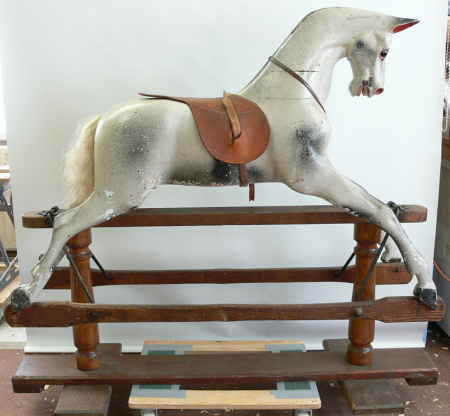
This particular horse, unrestored but not in original paint, is a Swallow Toys No. 21 Rocking Horse and is very similar to the Lines No. 21 horse, often being confused with it. Like Lines, the Swallow is a very well constructed and well carved horse with extra carving to the neck and legs, but there are subtle differences in the hoof rail shape and in the distinct hump shape at the top of the neck. Once stripped of paint and gesso, the construction of the Swallow is very distinctive, since extra thickening pieces of wood were attached at the shoulders and hind quarters in order to give a more generous body profile. Brackets are similar to Lines, having 2 screws and a bolt, and ‘bowler hats’ were fitted to cover the ends of the swing irons.
BRASSINGTON & COOKE of Manchester
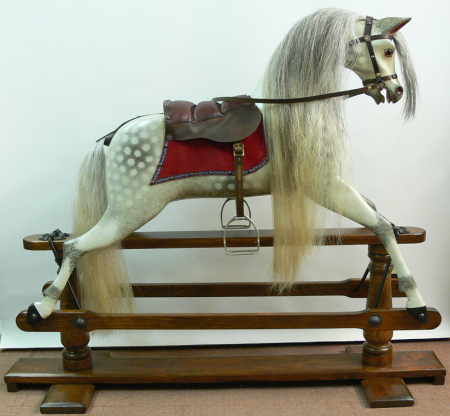
This restored rocking horse is typical of the Brassington & Cooke stable, having a strongly carved raised head with a wide brow and a well shaped and sturdy body with fairly delicate legs which did not have hoof notches. Stand columns are baluster shaped and the hoof rails paddle shaped with rounded ends. Each bracket consists of two metal strips bent over the swing irons in a hump shape. The horse in the photo had replacement Lines brackets. This particular horse had a stencil on the stand for Barr’s Deansgate Manchester, a large store where it would originally have been sold.
BABY CARRIAGES of Liverpool ‘Rambler’
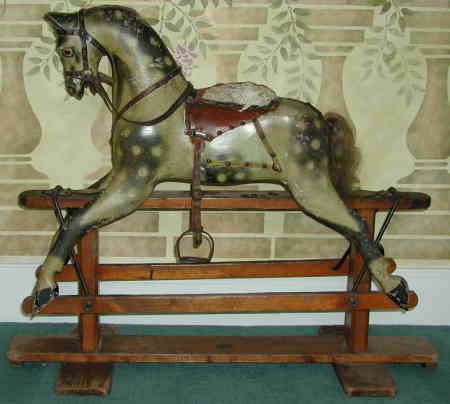
This small Baby Carriages rocking horse, in original paint, dates from the 1930’s and has a well shaped slightly ‘gathered’ head and well carved body. A feature which helps to identify old rocking horses by Baby Carriages were very distinctive brown glass eyes. The stand is a simple one. with square tapered columns fixed with nails, which are concealed with wooden diamond shaped lozenges similar to those of the Collinson rocking horses. This particular horse has a small transfer with the’Rambler’ trademark on the bottom rail of the stand. Earlier Baby Carriages horses have stands with turned columns, and the heads of the horses are much more drawn back towards the chest.
AJOY LTD of London
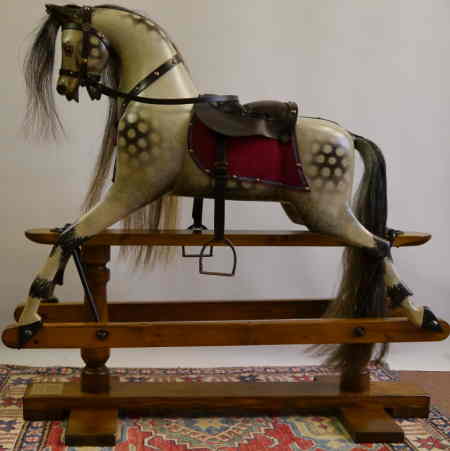
A fully restored medium Ajoy rocking horse, which shows the baluster turned stand columns and the sharply chamfered ends to the top rail which are typical of this maker. Brackets are three pointed and similar to those of Lines horses. Hoof rails are plain and rounded at theends. The very wide open mouth and rather pointed ends to the hoof also help with identification.
PATTERSON EDWARDS ‘LEEWAY’ of London
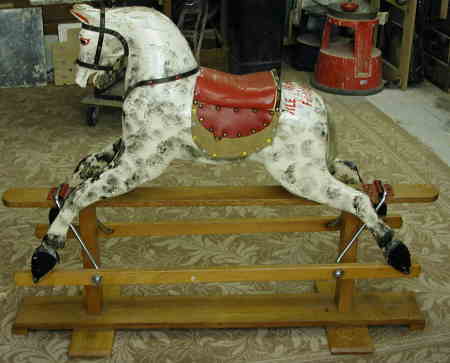
This Patterson Edwards ‘Leeway’ rocking horse has been overpainted and saddlery is not original. However it is not too difficult to identify old rocking horses by this maker, as the general shape of the body, rather large hooves, and square stand columns are typical of this model, as is the shape of the mouth. Brackets are simple pressed steel square plates. hump shaped to accommodate the swing irons. Once gesso is removed, the body reveals its unusual construction method, in which the legs extend unusually far up into the body section.
J. R. SMITH of London
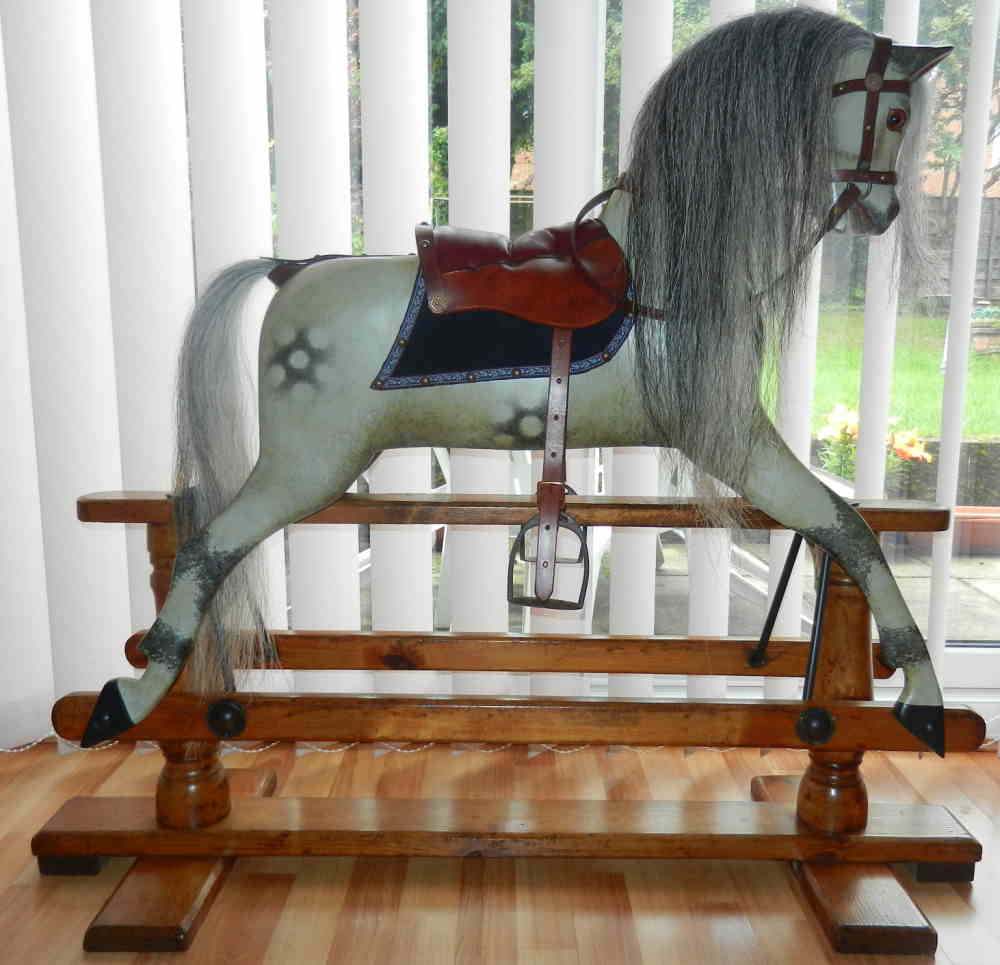
It is not always easy to identify old horses by J R Smith, however generally the hooves were unnotched and rather pointed and often the swing irons were almost vertical and directly over the top of the post columns. Brackets were Lines type fixed with two screws and a bolt, but often, as in this case, with the bolt end of the bracket facing inwards. Stand columns were turned, typically to the pattern in the photo above.
HISTORY of the DAPPLED GREY
Rocking horses of various shapes and sizes have been made for hundreds of years in many countries throughout the world. The classic English dappled grey rocking horse, which we have come to know and love, evolved during the Eighteenth and Nineteenth Centuries in response to the demands of an increasingly affluent society.
Initially only the landed gentry could afford such a luxury toy, and did so to give their children their first experience of a horse ride at a very early age. With the advent of the Industrial Revolution a new and wealthy middle class expanded rapidly and wanted the trappings of success, even in the nursery. To satisfy this need rocking horses were made in huge numbers, with the dapppled grey horse proving the most popular and chosen by both King George the Fourth and Queen Victoria. Many alternative colourings have been tried, but the Dappled Grey rocking horse has remained a consistent favourite with children of all ages.
BOW ROCKERS
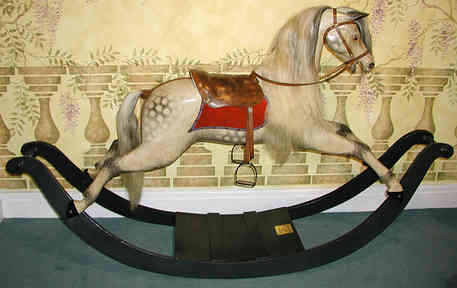
Early Georgian and Victorian rocking horses were mounted at full stretch on deeply curved bow rockers. However, experience showed that these elegant rockers could easily gallop around the house, posing a threat to their riders, furniture and onlookers alike.
SAFETY STANDS
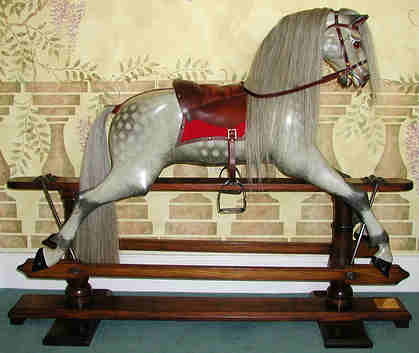
Many different types of rocking horse stand were tried without success until 1880 when an American, Philip Marqua of Cincinnati, took out a British patent on his invention, the Swinger or Safety stand. This proved very successful and steadily replaced the more precarious bow rockers, to become the style of choice.
